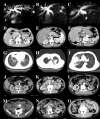Comparative Analysis of Clinical Characteristics in Multi-organ and Single-organ Involvement of IgG4-Related Disease: A Single-center Retrospective Study
- PMID: 40751524
- PMCID: PMC12305410
- DOI: 10.34172/aim.34027
Comparative Analysis of Clinical Characteristics in Multi-organ and Single-organ Involvement of IgG4-Related Disease: A Single-center Retrospective Study
Abstract
Background: Immunoglobulin G4-related disease (IgG4-RD) is a rare, chronic inflammatory condition characterized by fibrosis and tendency for multi-organ involvement. This study aims to analyze the clinical characteristics associated with multi-organ versus single-organ involvement in IgG4-RD, thereby enhancing clinicians' understanding of the differences between these two patient groups and ultimately improving patient prognosis.
Methods: We performed a retrospective analysis of clinical data from 82 patients diagnosed with IgG4-RD admitted to Yichang Central People's Hospital between January 2019 and December 2024.
Results: Among the 82 patients diagnosed with IgG4-RD, 47 patients (57.32%) exhibited involvement of multiple organs. The incidence of multi-organ involvement was significantly higher in male patients than female patients [63.49% vs. 36.84%, odds ratio (OR): 2.98, 95% confidence intervals (CI): 1.03-8.64, P<0.05]. The misdiagnosis rate in the multi-organ involvement group was significantly higher than that in the single-organ involvement group (29.79% vs. 8.57%, OR: 4.525, 95% CI: 1.19-17.26, P<0.05). In patients with involvement of the pancreas (72.50% vs. 42.86%, OR: 3.515, 95% CI: 1.39-8.86, P<0.05), or lymph nodes (83.72% vs. 28.21%, OR: 13.091, 95% CI: 4.50-38.11, P<0.05), the incidence of additional organ involvement was significantly higher than those with involvement of other organs. The eosinophil percentage [median difference (Hodges-Lehmann): 1.60%, 95% CI: 0.40-2.80, P<0.05], absolute eosinophil count [median difference (Hodges-Lehmann): 0.10×109/L , 95% CI: 0.30-0.16, P<0.05], serum immunoglobulin G (IgG) levels [median difference (Hodges-Lehmann): 4.10 g/L, 95% CI: 0.10-7.80, P<0.05], and erythrocyte sedimentation rate (ESR) [median difference (Hodges-Lehmann): 30.50 mm/h, 95% CI: 13.00-48.00, P<0.05] were significantly higher in the multi-organ involvement group compared to the single-organ involvement group. There was a positive correlation between the number of involved organs and ESR (r=0.404, 95% CI: 0.166-0.597, P=0.001), eosinophil percentage (r=0.287, 95% CI: 0.068-0.480, P=0.009), absolute eosinophil count (r=0.293, 95% CI: 0.075-0.485, P=0.007), serum IgG levels (r=0.370, 95% CI: 0.130-0.570, P=0.003), and serum IgG4 levels (r=0.370, 95% CI: 0.130-0.570, P=0.003).
Conclusion: The clinical features associated with multi-organ involvement in IgG4-RD are characterized by significant diversity and complexity. Clinicians must enhance their understanding of the characteristics associated with multi-organ involvement to more effectively improve patient prognosis.
Keywords: Clinical characteristics; Immunoglobulin G4-related disease; Organ involvement.
© 2025 The Author(s). This is an open-access article distributed under the terms of the Creative Commons Attribution License (https://creativecommons.org/licenses/by/4.0), which permits unrestricted use, distribution, and reproduction in any medium, provided the original work is properly cited.
Conflict of interest statement
The authors have no conflicts of interest to declare.
Similar articles
-
Sex as a predictor of clinical phenotype and determinant of immune response in IgG4-related disease: a retrospective study of patients fulfilling the American College of Rheumatology-European League Against Rheumatism classification criteria.Lancet Rheumatol. 2024 Jul;6(7):e460-e468. doi: 10.1016/S2665-9913(24)00089-4. Epub 2024 May 30. Lancet Rheumatol. 2024. PMID: 38824935 Free PMC article.
-
Histopathological Markers of Immunoglobulin G4-related Disease: Analyzing Diagnostic Patterns and Immunohistochemical Findings.Int J Surg Pathol. 2025 Sep;33(6):1393-1400. doi: 10.1177/10668969251316911. Epub 2025 Feb 23. Int J Surg Pathol. 2025. PMID: 39988963
-
Revealing the distinct clinical patterns and relapse risk factors in seronegative IgG4-RD patients: A retrospective cohort study over a decade.J Intern Med. 2024 Aug;296(2):200-212. doi: 10.1111/joim.13814. Epub 2024 Jun 24. J Intern Med. 2024. PMID: 38924246
-
Systemic pharmacological treatments for chronic plaque psoriasis: a network meta-analysis.Cochrane Database Syst Rev. 2021 Apr 19;4(4):CD011535. doi: 10.1002/14651858.CD011535.pub4. Cochrane Database Syst Rev. 2021. Update in: Cochrane Database Syst Rev. 2022 May 23;5:CD011535. doi: 10.1002/14651858.CD011535.pub5. PMID: 33871055 Free PMC article. Updated.
-
Systemic pharmacological treatments for chronic plaque psoriasis: a network meta-analysis.Cochrane Database Syst Rev. 2017 Dec 22;12(12):CD011535. doi: 10.1002/14651858.CD011535.pub2. Cochrane Database Syst Rev. 2017. Update in: Cochrane Database Syst Rev. 2020 Jan 9;1:CD011535. doi: 10.1002/14651858.CD011535.pub3. PMID: 29271481 Free PMC article. Updated.
References
Publication types
MeSH terms
Substances
LinkOut - more resources
Full Text Sources
Research Materials
Miscellaneous



